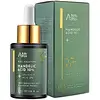What's inside
What's inside
 Key Ingredients
Key Ingredients

 Benefits
Benefits

 Concerns
Concerns

 Ingredients Side-by-side
Ingredients Side-by-side

Water
Skin ConditioningMandelic Acid
AntimicrobialNiacinamide
SmoothingSimmondsia Chinensis Seed Oil
EmollientOligopeptide-1
Skin ConditioningPortulaca Oleracea Extract
Skin ConditioningSalicylic Acid
MaskingAcacia Senegal Gum
MaskingMelaleuca Alternifolia Leaf Oil
AntioxidantHyaluronic Acid
HumectantTocopheryl Acetate
Antioxidant3-O-Ethyl Ascorbic Acid
Skin ConditioningIsononyl Isononanoate
EmollientRetinol
Skin ConditioningSaccharide Isomerate
HumectantCaprylhydroxamic Acid
Glyceryl Caprylate
EmollientPentylene Glycol
Skin Conditioning1,2-Hexanediol
Skin ConditioningWater, Mandelic Acid, Niacinamide, Simmondsia Chinensis Seed Oil, Oligopeptide-1, Portulaca Oleracea Extract, Salicylic Acid, Acacia Senegal Gum, Melaleuca Alternifolia Leaf Oil, Hyaluronic Acid, Tocopheryl Acetate, 3-O-Ethyl Ascorbic Acid, Isononyl Isononanoate, Retinol, Saccharide Isomerate, Caprylhydroxamic Acid, Glyceryl Caprylate, Pentylene Glycol, 1,2-Hexanediol
Water
Skin ConditioningButylene Glycol
HumectantPropanediol
Solvent1,2-Hexanediol
Skin ConditioningSalicylic Acid
MaskingCastanea Crenata Shell Extract
Skin ConditioningSodium Hydroxide
BufferingGlycerin
HumectantBiosaccharide Gum-1
HumectantEthylhexylglycerin
Skin ConditioningXanthan Gum
EmulsifyingHydroxyethylcellulose
Emulsion StabilisingDisodium EDTA
Citric Acid
BufferingDipotassium Glycyrrhizate
HumectantHyaluronic Acid
HumectantHydrolyzed Hyaluronic Acid
HumectantSodium Citrate
BufferingSodium Hyaluronate
HumectantSalix Alba Bark Extract
AstringentAllantoin
Skin ConditioningWater, Butylene Glycol, Propanediol, 1,2-Hexanediol, Salicylic Acid, Castanea Crenata Shell Extract, Sodium Hydroxide, Glycerin, Biosaccharide Gum-1, Ethylhexylglycerin, Xanthan Gum, Hydroxyethylcellulose, Disodium EDTA, Citric Acid, Dipotassium Glycyrrhizate, Hyaluronic Acid, Hydrolyzed Hyaluronic Acid, Sodium Citrate, Sodium Hyaluronate, Salix Alba Bark Extract, Allantoin
 Reviews
Reviews

Ingredients Explained
These ingredients are found in both products.
Ingredients higher up in an ingredient list are typically present in a larger amount.
1,2-Hexanediol is a synthetic liquid and another multi-functional powerhouse.
It is a:
- Humectant, drawing moisture into the skin
- Emollient, helping to soften skin
- Solvent, dispersing and stabilizing formulas
- Preservative booster, enhancing the antimicrobial activity of other preservatives
Hyaluronic acid is naturally found in healthy skin. It is a humectant, meaning it draws moisture to your skin.
This ingredient helps hydrate, soothe, and protect the skin.
What makes hyaluronic acid so hydrating? It has the capacity to bind or hold large amounts of water.
Fun fact: It is already naturally found in our bodies, such as the fluids of our eyes and our joints.
Studies find this ingredient to have anti-inflammatory and anti-microbial properties. This can help speed up wound-healing.
Hyaluronic acid can be irritating if the molecule has a low-molecular weight, or if the molecules are small.
One study found low-molecular weight hyaluronic acid to be pro-inflammatory, meaning some people may experience irritation. This is because our bodies use hyaluronic acid in the wound-healing process to signal to our bodies, via irritation, that something needs healing.
The same study found high-molecular weight hyaluronic acid to be anti-inflammatory.
These are some other common types of Hyaluronic Acid:
Learn more about Hyaluronic AcidSalicylic Acid (also known as beta hydroxy acid or BHA) is a well-known ingredient for treating skin that struggles with acne and clogged pores. It exfoliates both the skin's surface and deep within the pores to help clear out buildup, control oil, and reduce inflammation.
Unlike AHAs (alpha hydroxy acids), salicylic acid is oil-soluble. This allows it to penetrate into pores which makes it especially effective for treating blackheads and preventing future breakouts.
Salicylic acid is also known for its soothing properties. It has a similar structure to aspirin and can calm inflamed or irritated skin, making it a good option for acne-prone skin that is also sensitive.
Concentrations of 0.5-2% are recognized by the U.S. FDA as an over-the-counter topical acne product.
It can cause irritation and/or dryness if one's skin already has a compromised moisture barrier, so it's best to focus on repairing that before introducing this ingredient into your routine.
While salicylic acid does not increase sun sensitivity, it’s still important to wear sunscreen daily to protect your skin.
If you are looking for the ingredient called BHA or Butylated Hydroxyanisole, click here.
Learn more about Salicylic AcidWater. It's the most common cosmetic ingredient of all. You'll usually see it at the top of ingredient lists, meaning that it makes up the largest part of the product.
So why is it so popular? Water most often acts as a solvent - this means that it helps dissolve other ingredients into the formulation.
You'll also recognize water as that liquid we all need to stay alive. If you see this, drink a glass of water. Stay hydrated!
Learn more about Water